Since my look at M15 last week, we’ve had a lot of exciting new cards revealed, from the marquee planeswalker of the set all the way down to lowly but crucial lands. Every day I head over to the Magic subreddit at “Magic midnight” to check out the newly spoiled cards, and every day there’s something new that has the whole community in a tizzy.
It’s pretty amazing to compare the excitement surrounding Core Sets in the modern era – since the re-imagining of their role starting with M10 – to the sheer boredom with which they were received in the old era. Many newer players probably don’t even realize that prior to M10, Core Sets actually contained zero new cards. They were simply a home for reprints to increase the availability of particular cards and to determine what was legal in Standard (which was known as “Type 2” way back when).
A card’s presence or absence from a Core Set could have a significant impact on what the tournament scene looked like. The reprinting of Necropotence in Fifth Edition and the removal of Counterspell in Eighth Edition are major examples of these seismic shifts. What was in the Core Set was a big deal because it could totally define the competitive landscape, but it was still boring and sat unbought on store shelves because it didn’t have anything truly new in it.
Fast forward to 2009 and the announcement of Magic 2010 and all of that changed. Since then, not only have Core Sets been home to reprints that could determine the face of Standard for as long as they were legal, like Mana Leak or Lightning Bolt, but they also had shiny new cards for players to get excited about. Not only that, but they were designed with Limited play in mind, something that had been an afterthought at best in previous Core Set design. Rather than rotting on shelves, Core Sets since M10 have been extremely sought-after and popular, in no small part due to the juicy new Constructed cards they’ve featured.
Core Sets have been home to any number of hype-inspiring and format-defining cards since the change in design philosophy, from Baneslayer Angel and the Titans to the Rootbound Crag cycle of dual lands. The impact of M14 on current Standard is still enormous, even with two full blocks alongside it. Take a look at these core set cards that have shown up in top Standard decks lately:
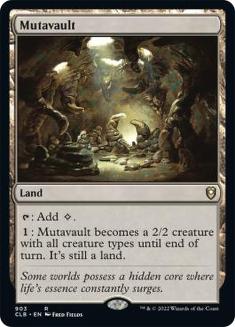
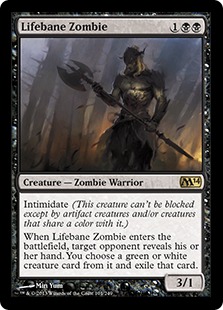
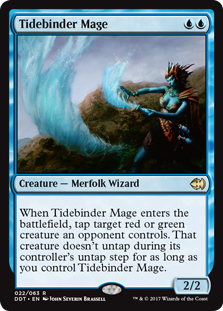
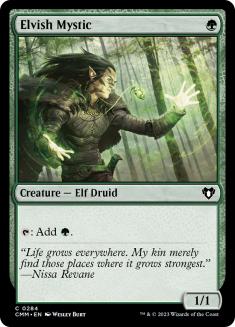
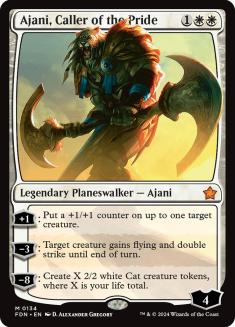
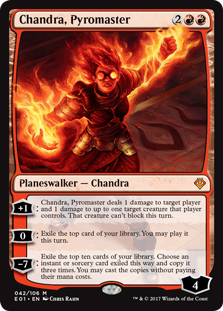

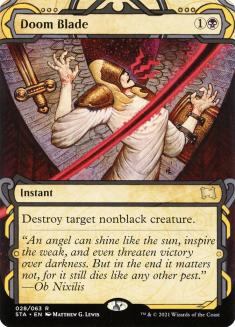
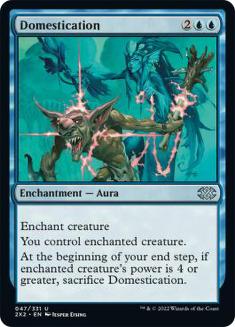
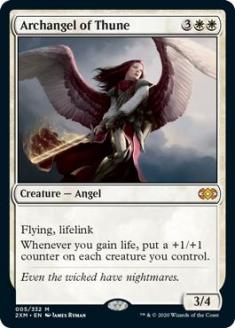
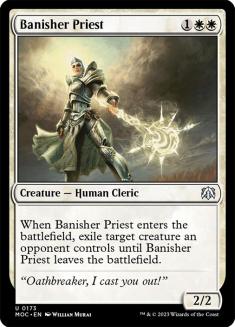
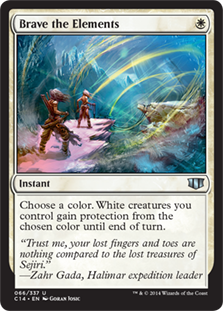
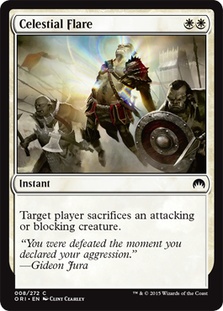
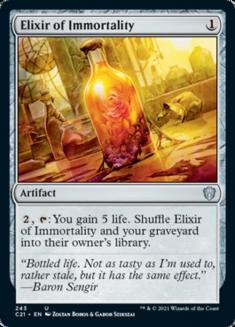
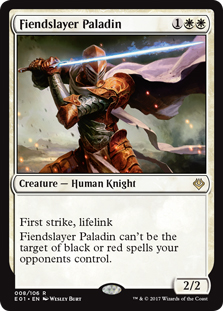
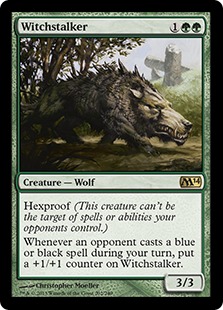
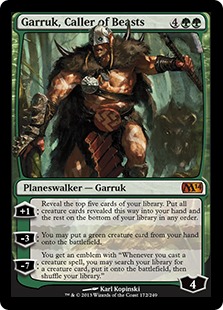
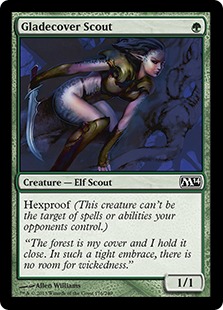
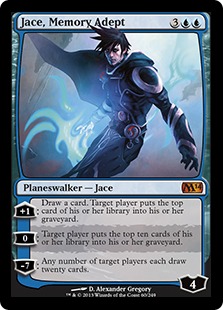
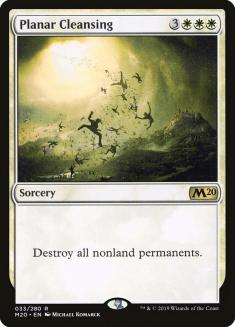
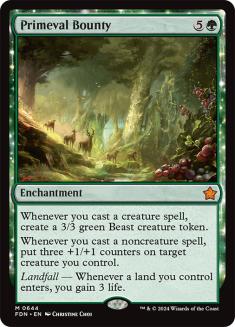
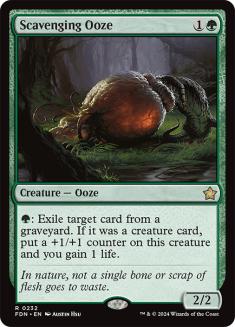
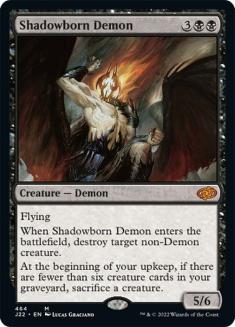
And that’s to say nothing of sideboard all-stars like Burning Earth, Negate, Staff of the Death Magus, or Eternal-format hits like Young Pyromancer!
The basic gist is that while once upon a time the Core Set was just a boring collection of reprints that came every year, now it’s awesome, and it’s a big deal. People love it, and rightfully so, because it’s full of sweet cards that shape the most-played format in the world for an entire year.
As long as you’re willing to forgive the absolute travesty of justice that is Lifebane Zombie, M14 was a smashing success, and M15 looks poised to follow in its footsteps.
Never forgive. Never forget.
Anyway… where were we when we last left our intrepid new-card-discussing hero? Ah, yes… last Friday, just before the Apocalypse painland cycle and the new Garruk were revealed. So let’s get back to it, shall we?
The biggest new reveal is clearly Garruk, Apex Predator:
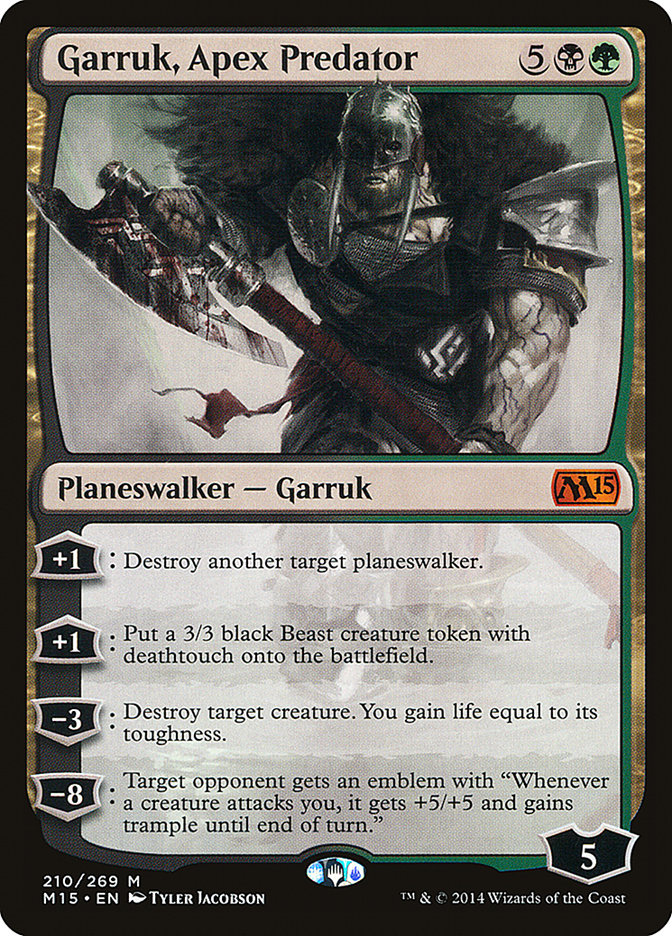
Like with most planeswalkers, there’s been a lot of discussion about this card, and public opinion is pretty divided. Garruk is clearly powerful – there’s no doubt about that. We haven’t seen a four-ability planeswalker since Jace, the Mind Sculptor, and that’s a pretty impressive pedigree. Of course, Jace cost nearly half as much as the new Garruk, which means he was able to put his four abilities to use much faster and more often than his veil-cursed brethren.
Once he is in play, though, Garruk is absolutely devastating. His ability to “hunt bigger game” manifests itself in a planeswalker-killing +1 ability. While this might not seem great immediately, what with the world we live in filled with Sphinx’s Revelation as the end-game of control decks, it’s almost certain to be a big deal in the not-so-distant-future. Anyone who paid attention to Pro Tour Journey into Nyx is likely to remember a certain Sun’s Champion dominating game after game whenever she came down. It sure would have been nice to have a trump card in those situations to take her out and put your opponent on the back foot, huh?
Garruk is the kind of card that can definitely put games away – and sometimes that’s just what you’re looking for. I’m sure a lot of you remember the various Golgari midrange decks I spent a lot of time toying with over the past few Standard seasons. One of the problems I was having with those decks was exactly that – actually finding a way to close out games. I could deal with just about anything that was thrown at me, but had trouble winning even once I got into an advantaged position. I tried everything from Polukranos and Vraska to Garruk, Caller of Beasts and Sylvan Primordial, but the former didn’t have quite the power needed and the latter was a clunky and inconsistent combo.
Garruk, Apex Predator is exactly the kind of card a deck like that would want. Against control decks, it can take out troublesome planeswalkers or generate a steady stream of deathtouch beasts as threats as it builds toward a game-winning ultimate. Against opposing creature decks, it can take out their biggest threat and get you some life back with the Sever Soul ability.
I don’t think Garruk will have a big splash right away since he doesn’t seem terribly well suited for a world full of Sphinx’s Revelations, but I do think he has the potential to be a major player during his time in Standard. If Pro Tour Journey into Nyx was any indication, we’re poised to move into a world centered around the pillars of Sylvan Caryatid and Courser of Kruphix, and that’s exactly where a card like Garruk will thrive.
If I were looking to build a deck around Garruk in the current Standard, it would probably look something like this:
Creatures (16)
Planeswalkers (3)
Lands (24)
Spells (17)

Obviously it’s a very rough draft, but basically a midrange green deck with a bunch of mana acceleration that can ramp into big creatures or a really, really big planeswalker. Three copies is probably too many of Garruk, but hey, we want to draw him if we’re building our deck around him.
One of the really exciting things about this list, in my mind, is the four copies of Mutavault. For most of Mutavault’s time in the current Standard, it’s been largely a luxury afforded to either mono-color Devotion decks or two-color control decks with tons of extra land, both of which can afford to skimp on colored sources to get access to the best utility land in the format. I’ve tried to sneak a few copies of Mutavault into most of my decks recently, but it can be difficult in aggressive or midrange strategies that need multiple colors of mana and are reliant on actually playing spells on-curve.
The big game-changer here is Llanowar Wastes, which is coming in M15 as part of the enemy-color painland cycle. These unassuming lands are quietly some of the most important cards in the new set, and have the potential to really shift the balance of power in Standard.
Ever since M13 rotated out and took with it the Rootbound Crag cycle, which Theros replaced with Temples, Standard has been heavily biased against multicolored aggressive decks simply because the available mana wasn’t good enough to support them. While Temples are fantastic for control decks like U/W and Esper, they’re terrible for decks that actually want to curve out and play their spells on time.
Even before I was playing Golgari midrange, I was trying to make Golgari aggro work. I managed to pilot it to a 7-0 record in the MOCS back in November before the crash heard ’round the world, but ultimately gave up on the deck after running into too many mana problems and problems hitting my curve with Golgari Guildgate in my deck.
Having Llanowar Wastes in the format means that colored mana is as good for aggressive decks as it was last summer, back when my G/R Aggro deck from the World Championships took the format by storm. If that deck could reliably cast Strangleroot Geist and Hellrider, we’ve got to be able to finally play a deck like this:
Creatures (28)
- 3 Scavenging Ooze
- 4 Dreg Mangler
- 4 Lotleth Troll
- 2 Desecration Demon
- 3 Experiment One
- 4 Elvish Mystic
- 4 Boon Satyr
- 4 Herald of Torment
Lands (23)
Spells (9)

I’ve wanted to play Boon Satyr and Herald of Torment side-by-side ever since the latter was spoiled, because they provide incredible late-game power despite being low on the mana curve. This deck tops out at only a pair of Desecration Demons, but it has a ton of use for extra mana thanks to the Bestow brothers and the Scavenge ability on Dreg Mangler.
Having zero lands that enter the battlefield tapped means you have fifteen sources of green mana on turn one, which makes both Elvish Mystic and Experiment One much better than in other versions. And if that’s not enough, you can cut the pair of Mutavaults for basic land or even Temples, but I have a feeling the mana is finally good enough to support them – after all, I did play a Kessig Wolf Run in my G/R list last year!
While I’m personally the most excited about Llanowar Wastes, since it’s basically the card I’ve wished for ever since Theros came out, the other pain lands open up a bunch of new possibilities as well. I would not be surprised to see more Boros decks spring up, since that was another aggressive guild that struggled with untapped colored mana sources and played Temples even though it really didn’t want to.
Unfortunately, there’s no new dual land for Selesyna, which could really use it. Voice of Resurgence is poised to rotate as the most expensive card in Standard to never make a real impact in its entire time in the format. Sunblade Elf is pretty sweet, sure, but what that deck needed more than anything is better mana.
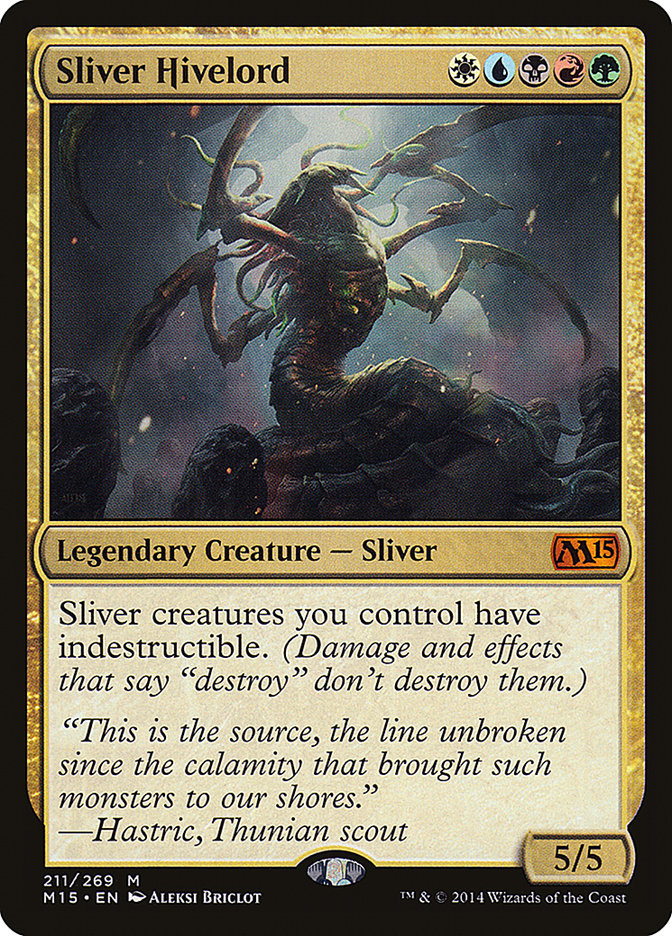
Speaking of mana – are the tools actually there to play Sliver Hivelord? A 5/5 for five mana that makes your entire team immune to Supreme Verdict is pretty incredible. Mana Confluence and Sliver Hive are a good start, especially alongside Manaweft Sliver. The non-Hivelord Slivers that we’ve seen in M15 so far don’t look incredible, but Hive and Hivelord may just be enough to make it a real deck.
What might that look like?
Creatures (32)
- 4 Bonescythe Sliver
- 4 Blur Sliver
- 2 Battle Sliver
- 2 Megantic Sliver
- 4 Predatory Sliver
- 4 Galerider Sliver
- 4 Manaweft Sliver
- 4 Sylvan Caryatid
- 4 Sliver Hivelord
Lands (24)
Spells (4)

This is obviously the roughest of rough lists, but gives a general direction of where you might go if you’re looking to maximize Sliver synergies. All of the lands produce green, so you can always cast Manaweft Sliver or Sylvan Caryatid, which help cast everything else in the deck. Alongside the Hivelord, Battle Sliver and Megantic Sliver give you uses for your extra mana to turn your Sliver army into an enormous force. It’s possible Hive Stirrings isn’t worth it and should be some kind of actual Sliver creature so you can get colored mana to cast it from Sliver Hive, but being able to make multiple Slivers with a single card seems pretty powerful when you have so many ways to pump them.
The window to actually play all of these Slivers in Standard is going to be very small, so I imagine this is one of the decks that will get a lot of attention right out of the gate. There weren’t quite enough tools to make it work with just M14, but the Hive and Hivelord give the tribe a whole new lease on life, and I would not be terribly surprised to see Sliver decks showing up in the Top 8 of events after M15 is released – there’s a lot of powerful stuff going on when they get going.
A few cards I want to touch on individually, like last time:
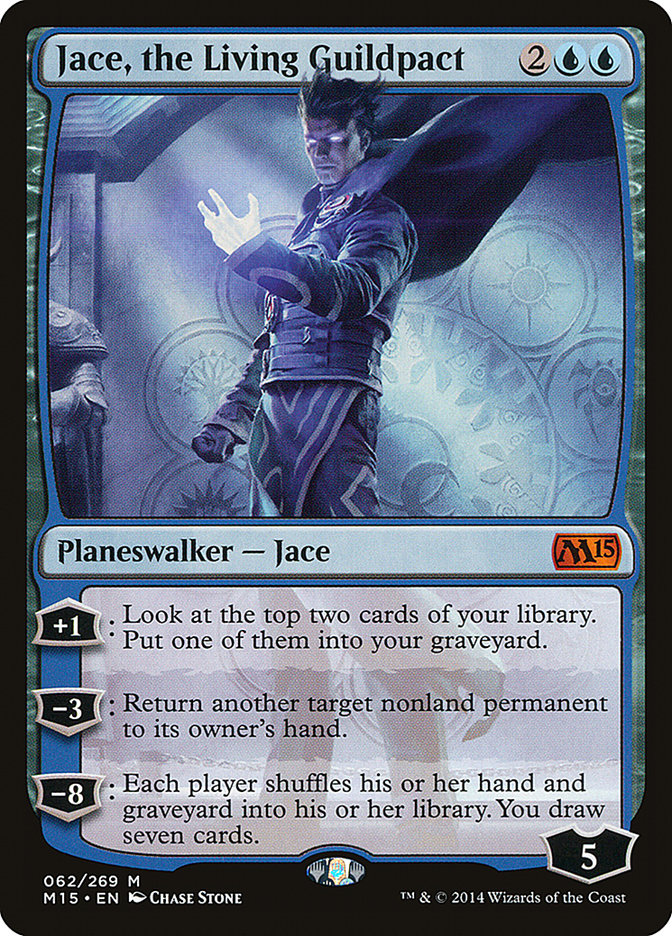
This isn’t really my kind of card, but I think it’s getting a lot more flak than it should be. Sure, it costs the same amount as Jace, the Mind Sculptor and it isn’t nearly as powerful, but there’s a lot of room for a card to be worse than a card that’s banned in Modern and still be good. This newest Jace starts at five loyalty and goes up to six the turn you play him, and while his +1 isn’t drawing you a card, it is giving you valuable card selection that’s better than Scry 1. The Temples have shown us that scrying is a powerful ability, and this is better than that while working toward a potentially game-winning ultimate just a few turns later.
His -3 ability isn’t as efficient as JTMS’s -1 at bouncing creatures, either, but it’s a lot more flexible since it can target any nonland permanent. You can free your other planeswalkers from Detention Sphere or Oblivion Ring and get a use out of them before your opponent can send them away again. You can also reset your other planeswalkers who are running out of loyalty, or re-use any creature with an enters-the-battlefield trigger, or bounce your opponent’s planeswalker that is about to ultimate. Mark my words – this Jace is better than you think.
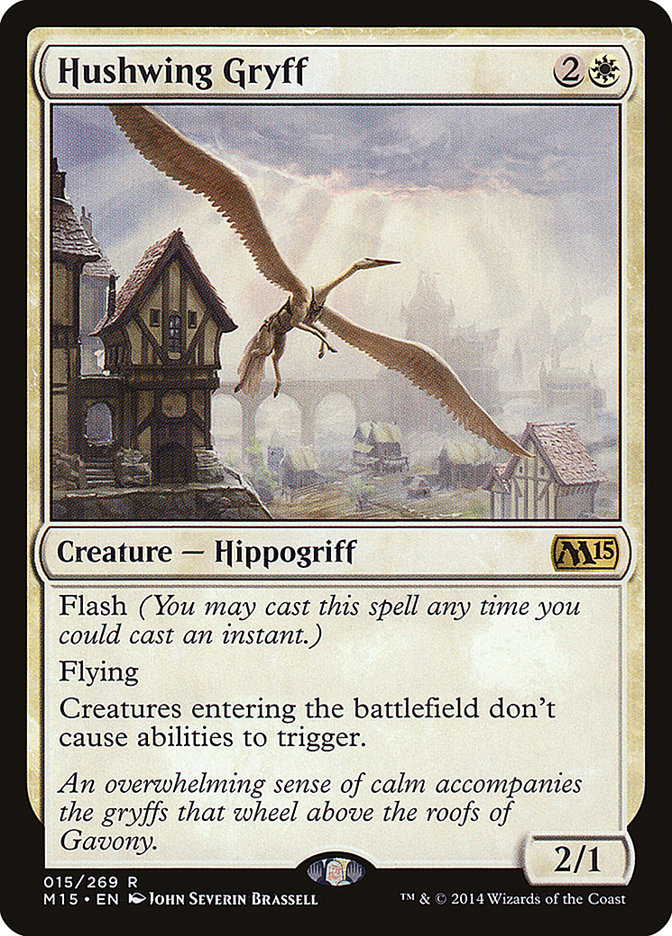
Most of my thoughts on this card have been about how awkward the new font looks in the word “Gryff,” but it seems pretty cool to play with, too. I don’t like this quite as much as Aven Mindcensor because it isn’t quite as devastating when it works – sure, your opponent doesn’t get their creature trigger, but they still get the creature, and most of the enters-the-battlefield triggers you’re looking to stop (in Modern, anyway) are infinite combos that they can just try again once they find a removal spell for your one-toughness creature.
I can certainly envision scenarios in which this guy is good, but I don’t think he’s the answer to Pod and Twin a lot of people seem to think he is.

See now this is why Aven Mindcensor is more awesome – it shuts down a card like this from doing almost anything! I don’t expect Chord of Calling to be great in Standard unless the format ends up with powerful instant-win creature combos like Modern. A lot of Birthing Pod decks in Modern cut the card, even! I do think it’s great that it cuts into the price of the card for those who are interested in playing it in Eternal formats and Commander, but it won’t be a major player in Standard.
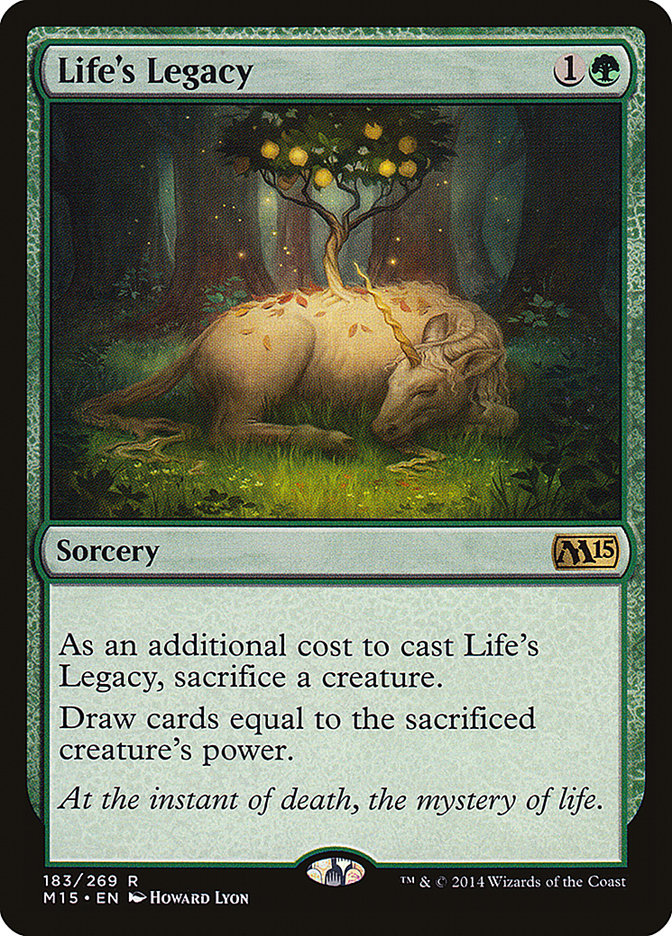
We’ve seen a lot of this kind of card in the form of Momentous Fall and Greater Good in the past. While this is the cheapest iteration we’ve seen, I still don’t expect it to make a big impact. Generally, when I get my big creatures into play, I want to keep them there! If this were an Instant so you could play it in response to a removal spell or sweeper, that would be a different story, but this is a sorcery that requires sacrificing the creature as part of the cost, so you’re especially screwed if your opponent happens to counter it. Maybe this shows up in some fringe situations with death triggers or in strange attrition matchups, but I don’t anticipate it being particularly good.
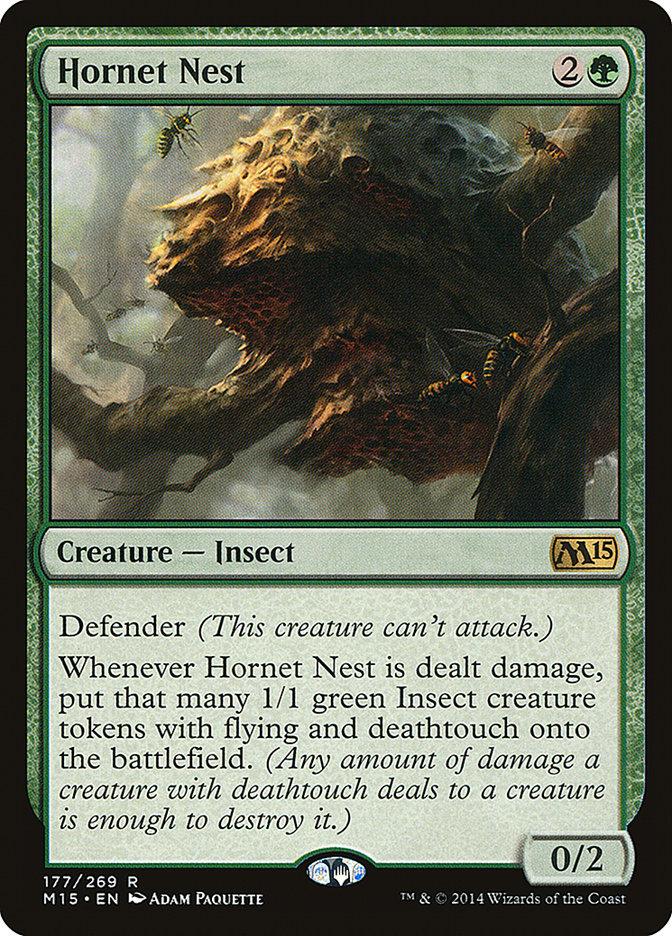
I just want to point out that this card is awesome. DON’T HIT THE NEST! IT’S FULL OF BEEEEEEES! (Okay, Hornets, but whatever.)
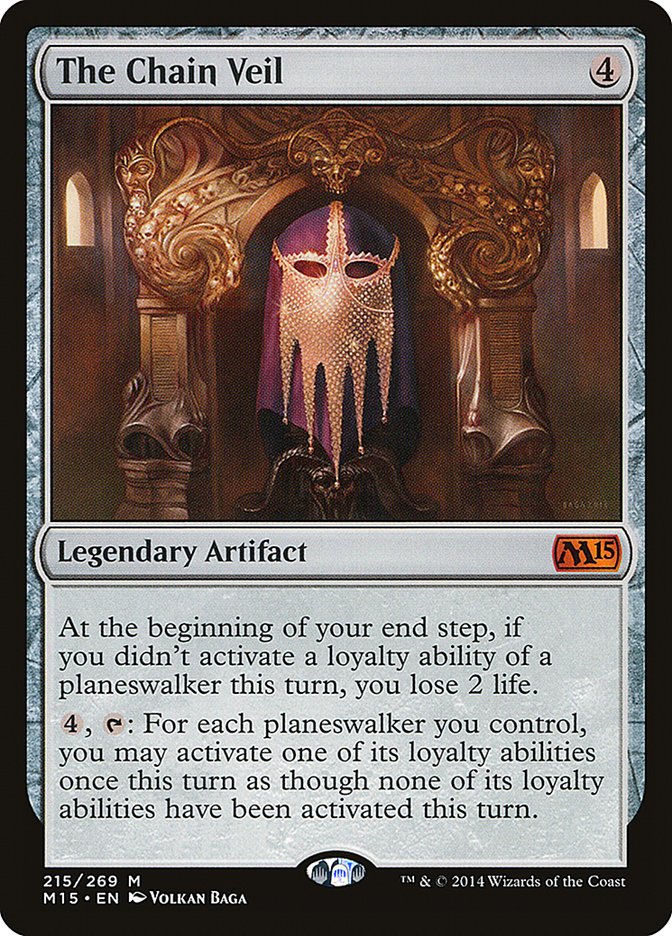
OMG YOU CAN GO INFINITE WITH RAL ZAREK AND NISSA AND FOUR FORESTS OR XENAGOS AND FOUR CREATURES!
Good luck with that. Attack you.
What do you think? What cards from M15 are going to have a big impact on Standard? Which will make a splash right away, and which will have to wait until rotation?
